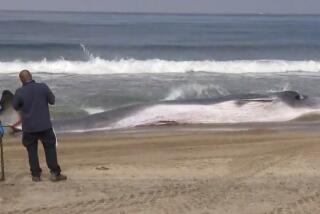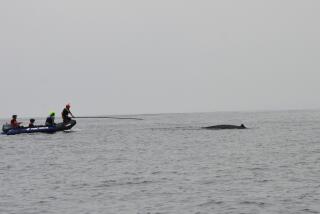FAIR GAME
Whale of a rescue
Last week in this space, we profiled Joan Venette, who spends her mornings atop the Palos Verdes Peninsula, monitoring the movements and behavior of whales as they pass through the San Pedro Channel. As I sat with her, I couldn’t help but marvel at how free the leviathans are, and how good life must be for them.
But then I got home and reality struck as abruptly as 30 tons of breeching blubber. News reports out of Hawaii told of two boats that had hit whales just since Christmas.
In Mexico, yet another whale had become entrapped in a fisherman’s net. A 40-foot humpback whale was found wrapped like a cigar in a monofilament, unable to even open its mouth near Cabo San Lucas at the tip of Baja California. “Her mouth was completely wrapped and sealed shut, her long pectoral fins were totally ensnared against her body and a huge wad of net was trailing down her body and around her tail,” reported www.seawatch.org, run by Portland-based Sea Watch, a conservation group dedicated to a healthier Gulf of California.
The floundering whale was discovered beyond Chileno Bay, a popular spot among snorkelers. Fortunately, a massive rescue effort was launched and divers worked tirelessly to cut the whale free.
“We kept cutting the monofilament and peeling it back away from her head, and finally her huge mouth was free of net,” Kevin Colter, one of the rescuers, said on the Sea Watch site. “We then worked our way back along her body, pulling the net back, cutting as we went, and began cutting our way through the lines that ensnared her pectoral fins.
“It was right at this point that the most amazing thing happened: She just stopped, whether from exhaustion or because she finally understood we were trying to help. She became very still and just floated, breathing through her blowhole quietly on the surface, while all of us continued to cut.”
Eventually, the net was removed and the whale was free. It swam away as a large crowd cheered the rescuers.
But free for how long?
Mexico has a 50-mile conservation zone to keep drift gill nets and long-line gear well offshore, but it also has opened an experimental -- and highly controversial -- shark fishery allowing this gear inside of 50 miles, and inside the gulf.
Mexico’s new fisheries chief, Ramon Corral Avila, last month generated a huge wave of optimism among conservationists when he declared that his agency would ban drift gill nets in all Mexican waters, and long-lines inside 50 miles by boats longer than 27 feet. But this, obviously, is much easier said than done. There was no timetable set for the ban, and no details about how it might be enforced.
Gray day
The southbound migration of California gray whales is gaining momentum. Through last Wednesday, the number tallied by Venette and fellow volunteers of the American Cetacean Society’s Gray Whale Census and Behavior Project was 272 -- slightly above normal for this time of year. Their destination: the mating and calving grounds inside Baja California’s balmy lagoons.
Not all the pregnant females could wait. There have been 29 calves sighted traveling with their mothers, a number well above normal. Not all the whales knew where they were supposed to be going: One was traveling northbound.
“Everyone’s whale watching this week, including dolphins,” volunteer Hugh Ryono said, via e-mail. “Lots of dolphins hanging around the migrating gray whales. Even California sea lions have been recorded swimming around grays with calves.”
Helping hands
Impoverished residents of the Ensenada, Mexico, area were given a small measure of relief recently, thanks in part to Southern California sportfishermen. As part of the Fish Across the Border program, nearly 4,000 cans of tuna donated by various San Diego fleets made its way into gift baskets passed around to needy families largely by members of the Ensenada and San Diego Rotary clubs. The groups also donated various cooking and household staples. Bob Fletcher, president of the Sportfishing Assn. of California, spearheaded the effort.
Back on the home front, Safari Club International will sponsor a meal of pasta and venison for the homeless of Nevada as part of the Sportsmen Against Hunger campaign at its annual convention this week in Reno. It runs through Sunday.
Flippin’ over bass
For what it’s worth to all you bass fishermen, flipping (or pitching) soft plastic worms was a technique that played a part in 24% of the victories in the two major bass tours (FLW and Bassmaster) in 2003, according to bassfan.com. Throw in the use of jigs, and the percentage increased to 32%. Spinnerbaits figured in 16% of the victories, as did crankbaits. Swimbaits, the large lures used to catch bigger fish, figured in only 1% of victories.
To e-mail Pete Thomas or read his previous Fair Game columns, go to latimes.com/petethomas.


